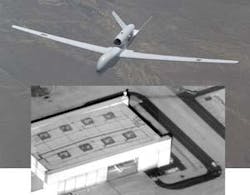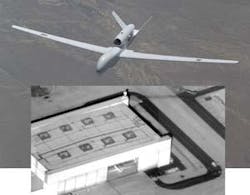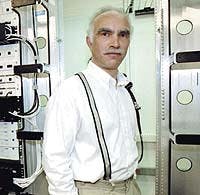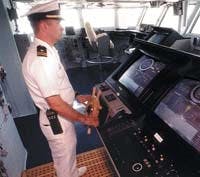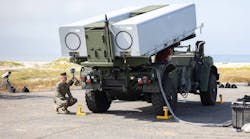By John McHale
Commercial-off-the-shelf has become the preferred way of doing business among power bus designers in military and aerospace applications such as the Global Hawk unmanned aerial vehicle. Meanwhile solid-state devices continue to make inroads into new designs.
The U.S. military relies heavily on the ability of its electronic surveillance and communication systems to fight the battles of the 21st century. The devices must not fail.
Designers of these military systems recognize that a key part of keeping these systems functioning properly is managing their power. The power bus of each aircraft, tank, or ship must maintain an uninterruptible flow of electricity from its generation at the engine, generator, or battery all the way to the user, such as the processor or radio. The power bus also must properly distribute, monitor, and switch electrical flow to prevent failure.
Today, designers in nearly all military systems are using commercial-off-the-shelf (COTS) equipment to manage power distribution. Former Defense Secretary William Perry's 1994 initiative to use COTS wherever and whenever possible has evolved to become the main method of procurement in powering military electronics. The devices that make up the power bus, such as distribution units, solid-state controllers, circuit breakers, and power converters are COTS devices.
Modern power components still meet military environmental guidelines, but they are available faster and at lower prices than mil-spec devices of the past. The COTS procurement phenomenon has come full circle, not only where it relates to power electronics, but where it relates to virtually all other military and aerospace electronic devices as well.
Steadily COTS has about done all it can, says Jeff Shepard, president of Darnell.com, a market research firm in Corona, Calif., that covers virtually anything to do with power. It has become the way that most military electronics companies do business, he adds.
"It is pure economics," he continues. There was almost a blank check for military spending in the 1980s, he says, but in the mid-1990s that all changed and now the U.S. Department of Defense is very cost-sensitive.
COTS has a huge time-to-market advantage that in some cases makes up for small decreases in efficiency, Shepard says.
The benefit of COTS is the fast track it offers from vendor's shelf to system design-in, says Mike Pitka, product marketing manager for motor drives and remote control power at Data Device Corp. (DDC) in Bohemia, N.Y. Custom devices have substantially longer design cycles than COTS, he adds.
The power-management market for the military is very much a COTS world, says Len Marsalla, director of marketing for the Power Technology group at Spectrum Control in Fairview, Pa. Spectrum Control makes rugged power distribution units with EMI filtering for military ground applications in 28 and 48-volt buses. Spectrum Control customers can get rugged power supplies for environmentally demanding applications quickly, where before COTS the prices were higher and the products took longer to turn around, he says.
In addition, COTS devices have improved to where they are not any less rugged and they have even better performance that the old mil-spec products, Marsalla says. Power devices from Spectrum Control are not commercial-grade products, he points out, yet they are commercially developed and available off the shelf. Most companies like Spectrum Control offer separate lines of commercial- and military-grade products available off-the-shelf, he says.
The company's ruggedized 48-volt power distribution unit has redundant power via Oring diodes, continuous load capacity of 50 amps per side, is 23-inch rack mountable, and is designed for steady state operation at 40 degrees Celsius, with no air flow. For more information on Spectrum Control's products contact the company on the World Wide Web at http:// www.spectrumcontrol.com.
One of the things that makes Vicor's power converters appealing is that they are all COTS devices, says Keith Nardone, military product manager at Vicor in Andover, Mass. Vicor makes high-density power converters for military aircraft and vehicles.
At Vicor, the primary sales point is price per watt, Nardone says. All Vicor power devices are COTS, he adds. Vicor's DC-DC converters fly on the U.S. Air Force F-22 Raptor and F-16 Falcon jet fighters. For more information on Vicor's power converters contact the company on the World Wide Web at http://www.vicr.com.
Another COTS trend involves the customer's growing desire for a standard product that has a little custom tweak here or there to make it fit the application, says William Standen, vice president of marketing and sales at Martek Power S.A. in Los Angeles. It is a type of value-added approach, he adds.
However, COTS has its own problems, says Alfredo Ramirez, deputy chief engineer for the Global Hawk unmanned aerial vehicle (UAV) at the Northrop Grumman Ryan Aeronautical Center in San Diego. Program managers must be vigilant of the COTS components that come in from suppliers, he says.
"Sometimes they will make tweaks or subtle changes to their products that you don't expect," he says. "It's a different philosophy now." Before COTS the burden was on the suppliers to make sure everything was mil-spec and properly documented and tested; now the situation is reversed.
One application area where COTS technology is not the driving factor is space.
The high-radiation environment of space makes it difficult for COTS products to work in space, says Tiva Bussarakons, technical product manager in the International Rectifier high-rel component subsystems group in El Segundo, Calif. Most of International Rectifier's products for space are not COTS, he says.
International Rectifier makes high-voltage, high-speed power metal oxide semiconductor field effect transistors —better known as MOSFETs — for space such as their RIC7113 products, Bussarakons says. For more information on International Rectifier's power products for space contact the company on the World Wide Web at http://www.irf.com.
International Rectifier has become one of the major suppliers to the power applications, especially with acquisitions earlier this year such as Advanced Analog, a maker of power converters in San Jose, Calif., Shepard says.
"We expect to see this consolidation among commercial mechanical manufacturers to continue," Shepard says. Especially since companies such as Lucent and Nortel have dropped mechanical manufacturing operations and are outsourcing, Shepard explains.
Global HawkThe new Global Hawk UAV from by Northrop Grumman Ryan Aeronautical has a power bus that is made up entirely of COTS equipment. As large as a manned aircraft, Global Hawk can fly 1,200 miles to an area of interest, remain on station for 24 hours, survey an area of 60,000 square nautical miles — roughly the size of Illinois — and then return 1,200 miles to its operating base.The UAV has a range of 13,500 nautical miles, at altitudes as high as 65,000 feet and endurance of 36 hours. During a typical mission, the Global Hawk sensor suite can provide near-real-time imagery of the area of interest to the battlefield commander via satellite.
A hydraulic pump, which is attached to the landing gear box, generates the AC power on the UAV, Ramirez says. It generates 110 AC volts, which then converts to 28 volts DC before it hits the electronics, he says. In case of generator failure, the aircraft switches to battery backups, which enable control of the vehicle for a safe landing, he says.
The majority of the electronics on the aircraft use DC power, Ramirez says. The only ones that do not are devices used for mission-critical wideband communications, which require AC, he says.
Low-power electronicsThe current power bus on most aircraft — with Global Hawk as an exception — is 270 volts DC, Martek's Standen says. There also are systems designers looking at power buses powered by as many as 800 volts, he adds. This trend toward increasingly high power system voltages, coupled with ever-shrinking device power consumption, presents system engineers with a thorny design problem. Individual devices such as processors, displays, and radios typically operate at 3.3 volts and less, Standen says.The concern involves the potential for power fluctuations in the system. The dynamic range of voltages is increasing, Darnell's Shepard says. For example on some aircraft 270 volts are generated and eventually converted to around 3 volts and even less for some electronics, he explains. That is about a ten-to-one dynamic range, Shepard says, and it is only going to increase. At the same time, devices that are increasingly power efficient also are increasingly prone to damage from power spikes and dropouts. At less than a volt, one little fluctuation in voltage can upset the entire device, therefore converter manufacturers are feeling the pressure to be even more efficient, Standen says.
The density of power circuitry must increase to help cope with the high dynamic ranges, Shepard says. Systems designers also must monitor the effectiveness of the converters, he says.
There is no doubt that the manufacturers of power converters are going to feel the heat to make what are already highly efficient devices even better, Standen says. Martek designs and manufacturers semi-custom power supplies such as the PSD-208 DC-DC Multiple Output, a design for the Global Hawk's synthetic aperture radar, Standen says. The device is a 900-watt DC-DC converter with 11 outputs and 8 SM series modules and circuitry, Standen says. For more information on Martek's products contact the company on the World Wide Web at http:// www.abbottelectronics.com.
Solid stateDemand for solid-state power controllers is growing quickly as system designers look past the initial cost and embrace the technology's improving reliability and performance, experts say. Solid-state devices are the next step up from thermal mechanical parts, DDC's Pitka says. They are more reliable and have no moving parts, which makes for less downtime, he says.While customers may pay more for these at the front end, they will save in the long run due to low maintenance of solid-state products, Pitka explains. The technology is primarily for new designs and major architecture upgrades, Pitka says. It is not a pin-for-pin replacement for thermal parts, he adds. It enables users to manage power more effectively, Pitka says.
DDC's DC-power solid-state devices are designed into the U.S. Army's M1A2 main battle tank and the company is currently developing an AC power controller, Pitka says. For more information on DDC contact the company on the World Wide Web at http://www.ddc-web.com.
"Previous power distribution systems employed large, heavy, expensive, and relatively unreliable electro-mechanical circuit breakers as switches and protection devices," says William Froeb, product line manager at National Hybrid in Ronkonkoma, N.Y. "All power lines in the system had to be routed to a cockpit breaker panel to allow command personnel physical access to the control elements.
"Running heavy power lines from the power sources, up to the breaker panel and back to the loads, adds a substantial amount of wait to the platform," he explains. "In commercial aircraft, for example, one pound of weight will result in approximately a $75,000 cost to the operation of the aircraft over its lifetime."
National Hybrid engineers have developed a concept they call SMART-C, which combines the company's Smart Switch and the Smart Controller. The Smart Switch is a low-loss power switch with built-in short circuit self-protection, National Hybrid officials say. It supplies load current, load voltage, and status information to the Smart Controller. The Smart Controller uses this information to perform status-reporting functions.
"Although previous solid-state power controller configurations offer complete, autonomous protection of the power distribution system, they are not necessarily the most cost-effective approach," Froeb says. "The stand alone implementation using individual solid-state devices creates redundant decision making circuitry. This increases the complexity and cost of the power management system."
National Hybrid engineers also use their SMART-C concept to develop power-distribution boards. This enables a modular implementation of power management and control functions, National Hybrid officials say. The company provides solid-state power controllers for the F-22 and the International Space Station. For more information on National Hybrid contact the company on the World Wide Web at http://www.nationalhybrid.com.
The Aerospace Corp. developing power bus for wearable computersExperts at The Aerospace Corp. in El Segundo, Calif., are developing a power bus for soldiers of the future that is woven directly into the soldiers' clothing. The power bus is the first step in the company's work to design a wearable computer for soldiers on the battlefield."We have a technology and point design that can deliver power and communications to these locations and offer a whole new set of placements for wearable digital devices in many forms," says Michael Gorlick, a project engineer in The Aerospace computer systems division. "In short, our goal is to transform clothing into a digital infrastructure that provides power and communications to other wearable devices." When designing small, wearable computers, you have to consider weight, power consumption, thermal effects, and packaging — in this case, clothing, Gorlick explains.
"Wearable devices must adapt themselves to the human form," he continues. "Digital devices will eventually be carried in pockets, purses, and waist packs, hung on belts and straps, worn as pins, brooches, and rings, or attached to arms, wrists, and ankles as bracelets or with straps as we now do with a wristwatch."
The goal of wearable computing "is to create digital devices that are as easy to don and as comfortable to wear as common articles of clothing such as blouses, pants, and belts," writes Gorlick in a paper to the 1999 International Symposium on Wearable Computers in San Francisco entitled "Electric Suspenders: A Fabric Power Bus and Data Network for Wearable Digital Devices."
Wearable computer equipment woven into clothing is an alternative to placing electronics in the soldier's knapsack, which can weigh him down in tough terrain. Today's concepts for the Army's Land Warrior program also involve cables linking separate devices. These cables can catch on brush or even tangle around the soldier's neck, he continues. Excess heat can also be a problem, Gorlick adds.
The advantages of a common power bus and data network, shared by two or more wearable devices, include a shared central power source, one battery doing the work of many, a reduction in the risk of battery failure, and quick installation of additional batteries, he writes.
Beginning with experimental conductive webbing, Gorlick designed suspenders that function as a power bus and data network for wearable digital devices, he says. The demonstration bus used a 7-volt lithium ion battery as its power source with "surface mount DC-DC converters no bigger than a match head," Gorlick says. The battery fits right into the user's pocket, he adds.
The goal is to have a uniform voltage of 12, that will be feasible once designers figure out a way to use copper as a conductor, Gorlick says. Since their first demonstration The Aerospace Corp.'s engineers have come up with a way to insulate copper wiring, but are still working on the patent and cannot comment on it, Gorlick says. "However, I can tell you it's quite slick."
New forms of woven materials, such as conductive webbing that integrates durable electrical conductors directly into the matrix of the weave, offer possibilities for closely integrating digital electronics with conventional clothing — a potential boon to the soldier in the field, company officials say.
"Webbing woven in various widths is used for belts, carrying straps, and harnesses," Gorlick writes. "Common materials include cotton, Kevlar, Nomex, nylon, polyester, and various mixes of these materials. Webbings can, by varying the yarns, the weave, the thickness, and the width, be engineered to precise specifications including strength, durability, and flexibility.
"We use a webbing made of Nomex with two pairs of stainless steel conductors woven directly into the webbing," Gorlick says. "Nomex is a fiber created by Dupont that has a temperature resistance as high as 500 degrees Fahrenheit." It is the fabric used by firefighters, he adds.
"The four conductors are uninsulated; the Nomex yarn is itself the insulator," he writes. "We bond each conductor pair together at the ends of each webbing segment to produce two single conductors, one on either side of the webbing. The webbing and its conductors withstand all of the rigors of industrial washing," Gorlick states in his paper. "However, it is not waterproof and if wet the conductors woven into the webbing will short. Consequently the webbing, as presently constituted, is unsuitable for use outdoors or in humid or damp environments. Nonetheless, with suitable precautions, it can be used indoors in many circumstances and settings such as offices, homes, and schools."
The problem with embedding sensitive electronics into clothing is protecting the electronics when the clothing is cleaned, Gorlick says. Chemicals that clean fabrics such as industrial soap are corrosive and can destroy electronics, he explains.
Clothing exists in a very stressful environment, where it is subject to ripping, perspiration, and repeated washing — a process not recommended for electrical connectors or other sensitive devices, he adds.
The power bus uses two forms of connectors — end connectors and surface connectors, Gorlick says. "End connectors are attached to the ends of the webbing to couple segments together or terminate it at end devices. Surface connectors are placed on the surface of the webbing," he writes.
Surface connectors can go anywhere on the webbing surface, enabling devices to attach at any point along the length of the webbing, Gorlick states. "Our surface connectors are an adaptation of conventional ball and socket sew-on snaps," he writes. "They are widely available in sizes ranging from approximately 5 to 8 millimeters in diameter."
External devices are attached to the clothing via a button-like snap, Gorlick says. It has kind of an electronic Velcro effect, he adds.
"The goal is to have very-large-scale information architecture for battlefield applications. We want to be able to send to, and receive information from, the soldier on the battlefield," Gorlick says, adding that the technology will not be developed for a few years.
For more information on the power bus for wearable computing contact The Aerospace Corp. on the World Wide Web at http://www.aero.org.
COTS products manage power on integrated bridge systems for Navy shipsThe integrated bridge System (IBS) from Northrop Grumman Sperry Marine in Charlottesville, Va., which is on several different U.S. Navy ships, uses commercial-off-the-shelf (COTS) technology for power management.Most of the hardware in the system itself is COTS, such as the processors and displays, says Carroll Foster, business unit director of Military Integrated Bridge Systems at Northrop Grumman Sperry Marine. The IBS needs clean power — the same as would be in the typical household desktop computer — because the systems employ similar equipment, he adds.
The value-added for IBS comes in the software, Foster says.
Any boards and processors that systems designers need for power management they can buy right off the shelf, says Pat Enright, director of machine automation Northrop Grumman Sperry Marine. Company engineers rarely modify the hardware, and make modifications typically in software, he adds.
The IBS are on U.S. Navy aircraft carriers, Ticonderoga-class cruisers, and San Antonio-class amphibious transport dock ships, Foster says. They are also part of the military sealift command, he adds.
An integrated bridge is a systems approach for the automated collection, processing, and display of the ship's navigation and other sensor data so ship commanders can operate and navigate the ship with relatively few crewmembers on the bridge. The IBS digitizes navigational charts and other tools and manuals so that a commander can access any information he needs anywhere on the bridge and even in his quarters, Foster says. It reduces the number of people necessary for bridge operations from 10 to three, he continues. It was used on the Navy's first smart ship, the Ticonderoga-class cruiser USS Yorktown, Foster adds.
The benefits of IBS include good situational awareness in low visibility, anchoring, and swept-channel conditions, automatic true motion plot, a vessel-monitoring system (VMS) records that fix every 15 seconds, chart inventory that is accessible on the local area network (LAN), CD ROM charts with easy maintenance requirements, VMS voyages that can be planned and changed in minutes, and a navigation picture available LAN-wide.
Power to the IBS comes from a diesel or gas turbine engine, and in some cases an electric drive, he says. The engines typically generate 115 volts of AC power, Foster says. Circuit breakers and cutout switches are also at points through which power flows, he adds.
Most surface ships use AC power, he continues, because weight is not as much of a concern as it is in aircraft, Foster adds. AC power typically needs heavier cabling than DC, he says. If the main engine does not involve an electric drive, the power generator for the ships is separate from the main propulsion of the ship, says Sperry Marine's Enright. Electric drives are in relatively newer vessels and are under consideration for the future Zumwalt-class land-attack destroyer (DD 21), he adds.
The power generation is balanced between two AC generators, with one able to back up the other in case one fails, he says. In case of a power failure, the system generates emergency power for rudder control.
The main power system is also automated and can be operated by remote control, Enright says.
For more information on integrated bridge systems contact the Northrop Grumman Sperry Marine operation on the World Wide Web at http://www.sperry-marine.com.
New power management algorithm extends battery life in portable electronicsEngineers at Galaxy Power in Valley Forge, Pa., developed a power-management algorithm that they claim can extend the life of portable computers and other devices used in the field. The first devices to use it will be platforms based on the StrongARM processor from Intel in Santa Clara, Calif."Our adaptive power management software solves the problems associated with traditional charging techniques," says Ed Arnold, president of Galaxy Power. "Conventional techniques perform arbitrary sampling over the life of the battery, introducing data distortions that can increase [equivalent series resistance] and capacity fade. In effect, actual capacity data sampled at arbitrary intervals without regard to the broader context of the battery's full potential, sabotages system performance and increases system costs."
The technology will be a big boost to any soldiers who use portable electronic devices in the field, says Steve Halla, manager for sales and marketing at Galaxy Power. Not only will their devices last longer, but also they will not have as many back-up batteries to carry around, which will reduce the weight they have to carry, he explains.
The QuickSaver adaptive power-management algorithms extend battery life by eliminating equivalent series resistance build-up and increase overall performance, Galaxy Power officials say.
Basically QuickSaver uses an adaptive approach, Hall says. Many solutions such as peak overcharge detect methods look at one empirical point as a cutoff for excessive heat and other problems, but QuickSaver manages these circumstances over time by adapting to them and balancing out the problems, he explains.
For example, the QuickSaver adaptive technique can double the life of a battery compared to peak overcharge detect methods, and the algorithm may increase battery life by 10 compared to "brute-force" time/temperature cut-off and constant-trickle overcharge methods, Galaxy Power officials say. QuickSaver is proven to increase discharge cycles anywhere from 50 to 100 percent, gaining an extra 90 minutes in run-time over the life of the battery, company officials claim.
For more information on Galaxy Power contact Steve Halla by phone at 610-676-0188, by email at [email protected], or on the World Wide Web at http://www.galaxypower.com.
